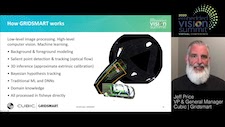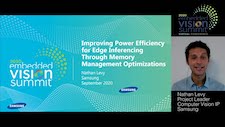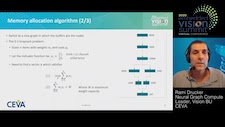| LETTER FROM THE EDITOR |
Dear Colleague,
You may have missed the live Embedded Vision Summit, but you don’t have to miss out on the content and know-how you need to advance your products and career in edge AI and computer vision. With the 2021 Embedded Vision Summit (On-Demand Edition) you can:
- Gain access to 85+ sessions on the most important current and emerging topics for creating visual AI-enabled products
- Watch Over-the-Shoulder Tutorials from Algolux, Coherent Logix, EdgeCortix, Edge Impulse, Intel, and LAON PEOPLE
- Learn from a panel discussion about one of the hottest topics: making production machine learning work without dozens of PhDs, and
- Visit exhibitors’ kiosks to learn more about their building-block technologies and products
Session content and kiosks will remain accessible through December 31, 2021. Take a look at the sessions, speakers, exhibitors and pass options (Lite pass: $49; Standard pass: $99), and then register today!
Brian Dipert
Editor-In-Chief, Edge AI and Vision Alliance |
| DISTRIBUTED PROCESSING |
|
Safer and More Efficient Intersections with Computer Vision
GRIDSMART is an edge computer vision system that uses omnidirectional imaging to detect and track objects through intersections to optimize traffic signal timing in response to traffic demands. The system comprises an IP fisheye camera mounted above the roadway, connected to an x86-based processor located in a roadside traffic cabinet. GRIDSMART is deployed in over 7,000 locations worldwide in about 1,300 communities. In this presentation, Jeff Price, Vice President and General Manager at Cubic | GRIDSMART, describes how GRIDSMART implements some of its current capabilities using traditional computer vision and machine learning techniques. He also discusses recently developed capabilities for protecting vulnerable road users that employ deep neural networks on the CPU using Intel’s OpenVINO toolkit. Additionally, he examines environmental requirements in the Intelligent Transportation Systems (ITS) application space as they relate to both computation and imaging, and the challenges these pose as the company looks to implement additional capabilities in the future.
AI is Leading the Way with Distributed Intelligence
Qualcomm is leading the way in distributed intelligence. The company’s vision is to make all devices increasingly intelligent, giving them the ability to perceive their surroundings, to reason based on data and then to act. In this talk from Ziad Asghar, Vice President of Product Management at Qualcomm, you’ll learn about the key technologies that Qualcomm has developed to take this vision from concept to reality. Qualcomm is giving devices the ability to see, hear, think and make decisions—and giving them the ability to learn. The company envisions this intelligence permeating through every part of the network from the edge to the cloud. In this presentation, you’ll learn how Qualcomm is enabling futuristic use cases such as real-time translation, superior contextual awareness with advanced audio and sensor technologies, enhanced camera use cases and many more.
|
| MEMORY RESOURCE MANAGEMENT |
|
Improving Power Efficiency for Edge Inferencing with Memory Management Optimizations
In the race to power efficiency for neural network processing, optimizing memory use to reduce data traffic is critical. Many processors have a small local memory (typically SRAM) used as a scratch pad which can be used to reduce the expensive data traffic to and from a big remote memory (e.g., DRAM). The specific structure of neural networks allows for advanced techniques to optimize the use of the local memory. In this presentation, Nathan Levy, Project Leader at Samsung, describes the key aspects of memory management optimization for neural networks along with the trade-offs that must be managed in light of the processor architecture and the details of the network. In addition, he shows the importance of tailoring the memory management approach to the specific network, illustrated by analysis of a case study.
Memory Allocation in AI and Computer Vision Applications
Efficient edge computing is the foundation underlying AI and computer vision applications in autonomous vehicles, cameras, drones and many other applications. Because deep neural networks (DNNs) are memory intensive, creating efficient implementations of DNNs requires efficient use of memory and memory bandwidth. In this talk, Rami Drucker, Machine Learning System Team Leader at CEVA, presents CEVA’s novel approach for efficient memory allocation to enable implementing DNNs under strict size and power constraints. The company’s approach utilizes a unified computational graph and takes into account the differing characteristics of different classes of memory (on-chip L1 and L2 SRAM and external DDR). Drucker also introduces CEVA’s XM6 and SensPro processors for vision and AI.
|
| FEATURED NEWS |
|
Chips&Media Launches AV1 Video Encoder Hardware IP for 4K/UHD Video Resolutions and Beyond
Sequitur Labs Announces EmPOWER SaaS Platform for Secure Lifecycle Management of IoT Devices
OpenCV Launches Modelplace.AI, a Marketplace for Artificial Intelligence Models
NVIDIA Unveils Jetson AGX Xavier Industrial Module
Virtual Seminar from Siemens Explores C-level Design and Verification Using HLS
More News
|
| EDGE AI AND VISION PRODUCT OF THE YEAR WINNER SHOWCASE |
|
Hailo Hailo-8 AI Processor (Best Edge AI Processor)
Hailo’s Hailo-8 AI Processor is the 2021 Edge AI and Vision Product of the Year Award Winner in the Edge AI Processors category. Empowered by its AI acceleration modules, which ensure seamless connectivity to any edge device, Hailo’s AI chip is transforming visual intelligence for multiple industries, enabling smart devices to run neural network-based applications such as detection and segmentation more effectively at the edge. The Hailo-8 processes high-resolution data streams in real time, enabling cameras to detect objects from greater distances. The chip is also capable of processing multiple camera streams on a single device, making it more cost-effective. And computing at the edge reduces the need to transport data to the cloud, enhancing data privacy.
Please see here for more information on Hailo and its Hailo-8 Processor. The Edge AI and Vision Product of the Year Awards (an expansion of previous years’ Vision Product of the Year Awards) celebrate the innovation of the industry’s leading companies that are developing and enabling the next generation of edge AI and computer vision products. Winning a Product of the Year award recognizes your leadership in edge AI and computer vision as evaluated by independent industry experts. |








